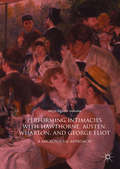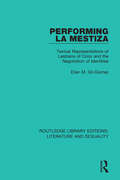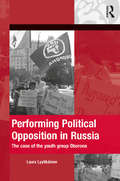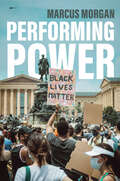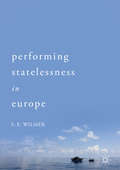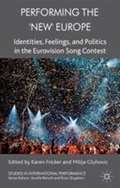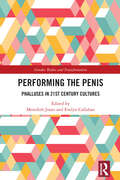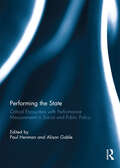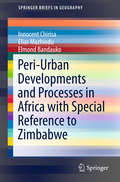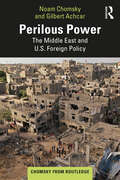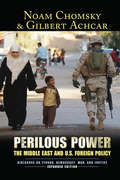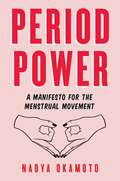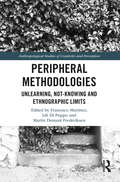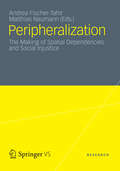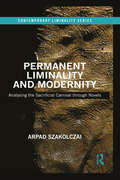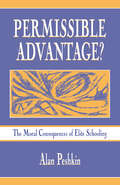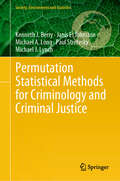- Table View
- List View
Performing Intimacies with Hawthorne, Austen, Wharton, and George Eliot: A Microsocial Approach
by Maya Higashi WakanaPerforming Intimacies with Hawthorne, Austen, Wharton, and George Eliot analyzes literary reproductions of everyday intimacies through a microsociological lens to demonstrate the value of reading microsocially. The text investigates the interplay between author, character, and reader and considers such concepts as face and moments of embarrassment to emphasize how art and life are inseparable. Drawing on narrative theory, the phenomenological approach, and macro approaches, Maya Higashi Wakana examines Hawthorne’s “The Minister’s Black Veil,” Austen’s Pride and Prejudice, Wharton’s Ethan Frome and The Age of Innocence, and George Eliot’s The Mill on the Floss. Through a multidisciplinary approach, this book provides new ways of reading the everyday in literature.
Performing La Mestiza: Textual Representations of Lesbians of Color and the Negotiation of Identities (Routledge Library Editions: Literature and Sexuality #4)
by Ellen M. Gil-GomezThis book, first published in 2000, explores the intersections of race, gender and gay identities in writings by contemporary American lesbians of colour in order to show how this subject is sometimes ignored, sometimes brutalised and is very rarely able to survive on her own terms by constructing her own identity acts of cultural revision. The author places the lesbian of colour in the context of current identity theories showing the ever-present blind spots within current theoretical paradigms, she then reads a variety of writings by lesbians of colour describing the possibilities that exist for these subjects in textual and social realities. The author shows the varied communities that threaten the existence of this subject, as well as the limits that dictate the subject's ability to create her self. By bridging Judith Butler's Gender Trouble and Gloria Anzaldua's New Mestiza she describes how lesbians of colour can survive numerous sites of hostility by constructing a positive identity within her home community through revising cultural traditions and history. After considering the power of these acts of revision, the author calls for the empowered performance of the mestiza state - the state of contradiction wherein the lesbian of colour finds herself. This book is the first to analyse creative and theoretical works by African American, Asian American, Latina and Native American communities and writers through the lens of lesbian studies. Authors include recognised figures such as Audre Lorde, Ana Castillo and Paula Gunn Allen, as well as lesser known authors like Best Brant, Natashia Lopez and Willyce Kim. It provides a corrective to Butler's empowering but essentially white vision of performing identity, so that lesbians of colour can claim their identities and remain tied to their own cultural traditions. Ultimately, the author asks for a reconsideration of the value of identity studies that articulate monolithic identities and whose analyses perpetuate what they seek to disrupt.
Performing New Orleans: Rethinking Resilience in Art and Everyday Life
by Stuart Andrews Patrick DugganPerforming New Orleans examines the value of arts and culture in managing complex urban challenges, offering new perspectives on how artistic and everyday performances can be pivotal modes of practicing resilience. Through an exploration of understudied forms of performance in New Orleans, Stuart Andrews and Patrick Duggan highlight the centrality of the city’s arts ecosystems as a vital aspect of its ability to “perform” resiliency.Performing New Orleans resists conventional definitions of arts practice; instead, it uses a diverse array of case studies to illustrate what arts practices are, what they do, and how they can enhance our understanding of people, place, and resilience. The case studies in this volume range from playing in the streets to painting murals; from tourist flourishes to the performative effect of infrastructure projects; from the design and leadership of arts centers to the unfolding of festivals, theater performances, art installations, and even public health messaging. The authors also review, critique, and rethink resilience theory and the often problematic idea of “being resilient.”Andrews and Duggan bring together ideas from art and architecture, cultural geography, hazard mitigation, resilience theory, sustainability, theater, and water management to explore “performances” of the city to radically expand our understanding of urban adaptability. Performing New Orleans argues that a truly resilient city is one that recognizes arts and culture professionals as crucial, critical innovators.
Performing Pedagogy in Early Modern England: Gender, Instruction, and Performance (Studies In Performance And Early Modern Drama Ser.)
by Kathryn M. MoncriefPerforming Pedagogy in Early Modern England: Gender, Instruction, and Performance features essays questioning the extent to which education, an activity pursued in the home, classroom, and the church, led to, mirrored, and was perhaps even transformed by moments of instruction on stage. This volume argues that along with the popular press, the early modern stage is also a key pedagogical site and that education”performed and performative”plays a central role in gender construction. The wealth of sixteenth- and seventeenth-century printed and manuscript documents devoted to education (parenting guides, conduct books, domestic manuals, catechisms, diaries, and autobiographical writings) encourages examination of how education contributed to the formation of gendered and hierarchical structures, as well as the production, reproduction, and performance of masculinity and femininity. In examining both dramatic and non-dramatic texts via aspects of performance theory, this collection explores the ways education instilled formal academic knowledge, but also elucidates how educational practices disciplined students as members of their social realm, citizens of a nation, and representatives of their gender.
Performing Political Opposition in Russia: The Case of the Youth Group Oborona (The Mobilization Series on Social Movements, Protest, and Culture)
by Laura LyytikainenDrawing on fieldwork conducted in Moscow and St. Petersburg among the political opposition’s youth group Oborona (Defence), this ground-breaking work brings forward a multifaceted and colourful image of the life of political opposition activists in a restricted political environment. Existing studies on youth political activism in Russia have mainly dealt with the pro-Kremlin youth movements, such as Nashi, while youth opposition activism has been studied very little. Lyytikäinen contributes to this gap by showing how youth are also actively organizing against the current government and how Russian oppositional youth activist practices are diverse and constantly evolving. Theoretically this book contributes to discussions on activist identities, as well as to an understanding of social movements and protest by analysing political protests as social performances. The research illustrates how Soviet continuities and liberal ideas are entangled in Russian political activism to create new post-socialist political identities and practices. It also questions the idea of Russian democratization being tied to its totalitarian past, and that of western-type liberal democracy being the goal of this process. Instead, the book proposes that Russian political culture should be analysed on its own, and as an entanglement of various interacting systems of thought.
Performing Power
by Marcus MorganWhen the bronze statue of Edward Colston was thrown into the Bristol harbour, what was it about this spectacle that made it more effective than countless petitions to have the slaver’s icon removed? What animated Trump’s supporters to answer his rhetorical question ‘who’s going to pay for the wall?’ during his 2016 presidential campaign? Why do leaders of social movements, or those seeking public office, bother to appear in front of audiences when they could just as well spell out their positions in writing?The central contention of this book is that the exercise of power, and struggles for power, are inextricably linked to social performance. Political success can often be explained by the presence of engaging drama, just as political failure can be accounted for by its absence. The book explores the role of social performance in the exercise of power and evaluates the main ways in which performances of power have been understood in the social sciences, developing its own unique model for understanding them. Morgan argues persuasively that the social sciences need to take seriously the aesthetic dimensions of power, showing that in power struggles, appearance matters, and appearance is in large part achieved through performance.Clearly written and illustrated with a wide range of contemporary examples, Performing Power will be of great value to students and scholars in political sociology, cultural sociology, and politics.
Performing Punk
by Erik HannerzPerforming Punk is a rich exploration of subcultural contrasts and similarities among punks. By investigating how punk is made, for whom, and in opposition to what, this book takes the reader on a journey through the lesser-known aspects of the punk subculture.
Performing Statelessness in Europe
by S. E. WilmerThis book examines performative strategies that contest nationalist prejudices in representing the conditions of refugees, the stateless and the dispossessed. In the light of the European Union failing to find a political solution to the current migration crisis, it considers a variety of artistic works that have challenged the deficiencies in governmental and transnational practices, as well as innovative efforts by migrants and their hosts to imagine and build a new future. It discusses a diverse range of performative strategies, moving from a consideration of recent adaptations of Greek tragedy, to performances employing fictive identification, documentary dramas, immersive theatre, over-identification and subversive identification, nomadism and political activism. This study will appeal to those interested in questions of statelessness, migration, and the problematic role of the nation-state.
Performing the 'New' Europe
by Milija Gluhovic Karen FrickerThis fascinating and lively volume makes the case that the Eurovision Song Contest is an arena for European identification in which both national solidarity and participation in a European identity are confirmed, and a site where cultural struggles over the meanings, frontiers and limits of Europe are enacted.
Performing the Penis: Phalluses in 21st Century Cultures (Gender, Bodies and Transformation)
by Meredith Jones Evelyn CallahanThis book will be the first collection that offers an overview and case studies around understandings and manifestations of penises and phalluses in the early twenty-first century. It examines how penises and phalluses are experienced and represented, drawing on examples from pornography, stripping, music video, film, surgery, and comedy. The penis—along with its twin the phallus—has been used to symbolise strength, fertility, and power but also bestiality, violence, and the ‘savage’. It has been worshipped, feared, and mocked. With contributing authors deploying conceptual frameworks based in philosophy, cultural studies, gender studies, affect theory, film theory, feminist theory, art theory, sociology, history, medical anthropology and media studies, this volume will appeal to a broad range of scholars and all who are interested in bodies, genitals, gender, and contemporary cultures.
Performing the State: Critical encounters with performance measurement in social and public policy
by Paul Henman and Alison GablePerformance measurement is now a key management tool used by government to assess and enhance public services. It is also used as a tool for public sector transparency and accountability. Despite these noble objectives, performance measurement can also generate counterproductive and sometimes paradoxical outcomes. This book innovatively conceptualises performance measurement as a ‘policy instrument’. Such an approach necessarily invites careful and critical examination of instances of the formation, application and contestation of particular performance measurement regimes, the tools used to measure performance, the way in which performance data is produced and used, and the complex dynamics between professionals, managers and service users that arise from these practices. The book provides detailed empirical examples of performance measurement in the delivery of health, schooling and child welfare services, as well as the problematics of assessing national wellbeing. Instead of a form of scientific and rational management, performance measurement is revealed as an intrinsically contested, socio-politically charged and value laden practice. The book concludes that to succeed in delivering authentic performance improvements public sector managers must be aware of these complex, paradoxical dynamics and the circumstances that make performance measurement perform. This book was originally published as a special issue of Policy Studies.
Peri-Urban Developments and Processes in Africa with Special Reference to Zimbabwe
by Innocent Chirisa Elias Mazhindu Elmond BandaukoThis book focuses on peri-urban development processes in Africa, with special emphasis on Zimbabwe. The debates included highlight a number of issues in the peri-urban context, such as access to water, appropriate technologies and land management, political economy in the peri-urban space, peri-urban agriculture, and place marketing in peri-urban development, among others. The debates raised by the authors in this book revolve around locating the peri-urban space within the context of sustainability, in which key issues are addressed. The book essentially examines peri-urban development processes from various angles in an effort to understand how peri-urban areas develop, function, and how their residents survive. Per-urban dwellers currently face numerous challenges, including land tenure insecurity, poor infrastructure and services, land use conflicts, stringent planning law and land use planning regulations. This work seeks to address the "knowledge gap" on peri-urban development processes in Africa, and is also intended to inform urban policy practice in the African Cities and beyond. Offering policy makers valuable insights on the peri-urban space, it provides guidance for decision-making in the contexts of service delivery, land management, housing, new town development and place marketing, among others.
Peri-urban futures: Scenarios and models for land use change in Europe
by Simon Bell Kjell Nilsson Stephan Pauleit Carmen Aalbers Thomas A. Sick NielsenPresently, peri-urbanisation is one of the most pervasive processes of land use change in Europe with strong impacts on both the environment and quality of life. It is a matter of great urgency to determine strategies and tools in support of sustainable development. The book synthesizes the results of PLUREL, a large European Commission funded research project (2007-2010). Tools and strategies of PLUREL address main challenges of managing land use in peri-urban areas. These results are presented and illustrated by means of 7 case studies which are at the core of the book. This volume presents a novel, future oriented approach to the planning and management of peri-urban areas with a main focus on scenarios and sustainability impact analysis. The research is unique in that it focuses on the future by linking quantitative scenario modeling and sustainability impact analysis with qualitative and in-depth analysis of regional strategies, as well as including a study at European level with case study work also involving a Chinese case study.
Perilous Power: The Middle East and U.S. Foreign Policy (Chomsky from Routledge)
by Noam Chomsky Gilbert Achcar Stephen R. ShalomUpdated with a new preface by Gilbert Achar, covering events since 2007 including the late-2023 renewal of military conflict between Israel and Hamas, this new edition provides readers with an essential critical perspective on the US role in the Middle East.The volatile Middle East is the site of vast resources, profound passions, frequent crises, and long-standing conflicts, as well as a major source of international tensions and a key site of direct US intervention. Two of the most astute analysts of this part of the world are Noam Chomsky, the preeminent critic of U.S. foreign policy, and Gilbert Achcar, a leading specialist of the Middle East who has lived in that region for many years. In this book, Chomsky and Achcar bring a keen understanding of the internal dynamics of the Middle East and of the role of the United States, taking up all the key questions of interest to concerned citizens, including such topics as terrorism, fundamentalism, conspiracies, oil, democracy, self-determination, anti-Semitism, and anti-Arab racism, the Israeli-Palestinian conflict, and the sources of U.S. foreign policy.This book provides the best readable introduction for all who wish to understand the complex issues related to the Middle East from a perspective dedicated to peace and justice.
Perilous Power: The Middle East and U.S. Foreign Policy Dialogues on Terror, Democracy, War, and Justice
by Noam Chomsky Gilbert Achcar Stephan R. ShalomThe volatile Middle East is the site of vast resources, profound passions, frequent crises, and long-standing conflicts, as well as a major source of international tensions and a key site of direct US intervention. Two of the most astute analysts of this part of the world are Noam Chomsky, the preeminent critic of U.S, foreign policy, and Gilbert Achcar, a leading specialist of the Middle East who lived in that region for many years. In their new book, Chomsky and Achcar bring a keen understanding of the internal dynamics of the Middle East and of the role of the United States, taking up all the key questions of interest to concerned citizens, including such topics as terrorism, fundamentalism, conspiracies, oil, democracy, self-determination, anti-Semitism, and anti-Arab racism, as well as the war in Afghanistan, the invasion and occupation of Iraq, the Israeli-Palestinian conflict, and the sources of U.S. foreign policy. This book provides the best readable introduction for all who wish to understand the complex issues related to the Middle East from a perspective dedicated to peace and justice.
Perinatal Depression among Spanish-Speaking and Latin American Women: A Global Perspective on Detection and Treatment
by Sandraluz Lara-Cinisomo Katherine Leah WisnerPerinatal Depression among Spanish-Speaking and Latin American Women A Global Perspective on Detection and Treatment Sandraluz Lara-Cinisomo and Katherine Leah Wisner, editors As more is known about postpartum depression, the more it is recognized as a global phenomenon. Yet despite the large numbers, information about this condition as experienced by Spanish speaking women and Latinas has not always been easy to come by. Perinatal Depression among Spanish-Speaking and Latin American Women focuses on four diverse Latina populations (Mexico, Chile, Spain, and U.S.) to analyze key similarities and differences within this large and wide-ranging group. This first-of-its-kind reference reviews current research on the topic, including prevalence, screening methods, interventions, and--of particular salience for this population--barriers to care. Findings on psychoeducation, assessment tools, and cognitive-behavioral and other forms of therapy provide important insights into best practices, and continuity of care. And psychosocial, cultural, and linguistic considerations in working with Latinas are described in depth for added clinical usefulness. This landmark volume: Outlines characteristics of Spanish-speaking women and Latinas screened for postpartum depressionIntroduces the Edinburgh Postnatal Depression Scale, English and Spanish versions, and reviews their use with Latina womenCompares postpartum depression and health behaviors in Spanish and Latina immigrant mothersOffers streamlined assessment-to-intervention modelsProvides two in-depth case studies illustrating cultural factors influencing the treatment of Latinas with perinatal depression.Presents an instructive firsthand account of postpartum depression. Between its thorough coverage of the issues and its innovative clinical ideas, Perinatal Depression among Spanish-Speaking and Latin American Women has a wealth of information of interest to researchers and practitioners in maternal and child health, obstetrics/gynecology, mental health, and women's health.
Period Power: A Manifesto for the Menstrual Movement
by Nadya Okamoto Rebecca ElfastPERIOD founder and Harvard College student Nadya Okamoto offers a manifesto on menstruation and why we can no longer silence those who bleed—and how to engage in youth activism.Throughout history, periods have been hidden from the public. They’re taboo. They’re embarrassing. They’re gross. And due to a crumbling or nonexistent national sex ed program, they are misunderstood. Because of these stigmas, a status quo has been established to exclude people who menstruate from the seat at the decision-making table, creating discriminations like the tampon tax, medicines that favor male biology, and more. Period Power aims to explain what menstruation is, shed light on the stigmas and resulting biases, and create a strategy to end the silence and prompt conversation about periods.
Peripheral Interaction
by Saskia Bakker Doris Hausen Ted SelkerComputing devices havebecome ever more present in our everyday environments, however embedding thesetechnologies into our routines has remained a challenge. This book exploresthe novel theory of peripheral interaction to rectify this. This theory examines how interactivesystems canbe developed in such a way to allow people to seamlessly interact withtheir computer devices, but only focus on them at relevant times, building onthe way in which people effortlessly divide their attention over severaleveryday activities in day to day life. Capturing the currentstate of the art within the field, this book explores the history and foundationaltheories of peripheral interaction, discussesnovel interactive styles suitable for peripheral interaction, addressesdifferent application domains which can benefit from peripheral interaction andpresents visions of how thesedevelopments can have a positive impact on our future lives. As such, thisbook's aim is to contribute to research and practice in fields such ashuman-computer interaction, ubiquitous computing and Internet of Things, a viewon how interactive technology could be redesigned to form a meaningful, yetunobtrusive part of people's everyday lives. Peripheral Interaction will be highly beneficial to researchers anddesigners alike in areas such as HCI, Ergonomics and Interaction Design.
Peripheral Methodologies: Unlearning, Not-knowing and Ethnographic Limits (Anthropological Studies of Creativity and Perception)
by Francisco Martinez Lili Di Puppo Martin Demant FrederiksenHow does peripherality challenge methodology and theory-making? This book examines how the peripheral can be incorporated into ethnographic research, and reflects on what it means to be on the periphery – ontologically and epistemologically. Starting from the premise that clarity and fixity as ideals of modernity prevent us from approaching that which cannot be easily captured and framed into scientific boundaries, the book argues for remaining on the boundary between the known and the unknown in order to surpass this ethnographic limit. Peripheral Methodologies shows that peripherality is not only to be seen as a marginal condition, but rather as a form of theory-making and practice that incorporates reflexivity and experimentation. Instead of domesticating the peripheral, the authors engage in (and insist on) practicing expertise in reverse, unlearning their tools in order to integrate the empirical and analytical otherwise.
Peripheralization
by Andrea Fischer-Tahir Matthias NaumannPeripheries emerge as a result of shifts in economic and political decision-making at various scales. Therefore peripheral spaces are not a "natural" phenomenon but an outcome of the intrinsic logic of uneven geographical development in capitalist societies. Discussing examples from Germany, Eastern Europe, Turkey, Iraqi Kurdistan, Pakistan, India and Brazil, the volume describes the social production of peripheries from different theoretical and methodological perspectives. In so doing, it argues in favour of a re-politicization of the recent debate on peripheralization.
Permanent Liminality and Modernity: Analysing the Sacrificial Carnival through Novels (Contemporary Liminality)
by Arpad SzakolczaiThis book offers a comprehensive sociological study of the nature and dynamics of the modern world, through the use of a series of anthropological concepts, including the trickster, schismogenesis, imitation and liminality. Developing the view that with the theatre playing a central role, the modern world is conditioned as much by cultural processes as it is by economic, technological or scientific ones, the author contends the world is, to a considerable extent, theatrical - a phenomenon experienced as inauthenticity or a loss of direction and meaning. As such the novel is revealed as a means for studying our theatricalised reality, not simply because novels can be understood to be likening the world to theatre, but because they effectively capture and present the reality of a world that has been thoroughly ’theatricalised’ - and they do so more effectively than the main instruments usually employed to analyse reality: philosophy and sociology. With analyses of some of the most important novelists and novels of modern culture, including Rilke, Hofmannsthal, Kafka, Mann, Blixen, Broch and Bulgakov, and focusing on fin-de-siècle Vienna as a crucial ’threshold’ chronotope of modernity, Permanent Liminality and Modernity demonstrates that all seek to investigate and unmask the theatricalisation of modern life, with its progressive loss of meaning and our deteriorating capacity to distinguish between what is meaningful and what is artificial. Drawing on the work of Nietzsche, Bakhtin and Girard to examine the ways in which novels explore the reduction of human existence to a state of permanent liminality, in the form of a sacrificial carnival, this book will appeal to scholars of social, anthropological and literary theory.
Permanent Red: Essays in Seeing
by John BergerWhy should an artist&’s way of looking at the world have any meaning for us? Any artwork reflects the artist&’s intentions, but also its times: therefore all art is politicalIn Permanent Red, John Berger argues that the contemporary artist should strive for a realism that aims for hope, to transform the world. Surveying the work of historical artists as well as that of near contemporaries such as Picasso, Léger and Matisse, he explores the role of the artist, dividing these figures into those that struggle, those that fail, and the true masters. He explains why we should study the work of the past: in order to understand the present and to rethink the future.First published in 1960, Permanent Red established John Berger as a firebrand critic willing to broadcast controversial opinions on some of the most important British artists of the day, including Henry Moore and Barbara Hepworth.
Permissible Advantage?: The Moral Consequences of Elite Schooling (Sociocultural, Political, and Historical Studies in Education)
by Alan PeshkinThis study of Edgewood Academy--a private, elite college preparatory high school--examines what moral choices look like when they are made by the participants in an exceptionally wealthy school, and what the very existence of a privileged school indicates about American society. It extends Peshkin's ongoing exploration of U.S. high schools and their communities, each focused in a different sociocultural setting. In this particular inquiry, he began with two central questions: * What is a school like whose students enter with a determined disposition to attend college, and all of whom are selected on the promise they display for college success? * What can be learned from studying Edgewood Academy that transcends the particular case of this school? The volume opens with a description of how moral choices look when they are made by the participants in an exceedingly wealthy school. There is a general picture of the Academy, a discussion of the processes the school uses to insure the quality of its students and educators, and an overview of teachers and students that reveals what is commendable about each group. These chapters clarify what a school of ample financial means and wise leadership can do. Peshkin goes on to reflect briefly on privilege and concludes with a discussion of what the very existence of a privileged school indicates about American society. Schools, he suggests, are about much more than what goes on inside them--they mirror what is and is not at stake for their particular constituents--and function similarly for the nation. Edgewood Academy's host community is not a village, town, church, or tribe, as in Peshkin's previous studies. It is a community created by shared aspirations for high-level academic attainment and its associated benefits. Affluence and towering academic achievement are the two most relevant factors. In this book, advantage occupies center stage. The school's excellence is documented not to extol its success, but, rather, to call attention to what is available for its students that is not available for most American children. The focus, ultimately, is on educational justice as illuminated by the advantage of Academy students--that is, on justice denied, not because anyone or any group or agency consciously, planfully sets out to do injustice to other children, but because injustice happens as the artifact of imagined limitations of resources and means. Peshkin's purpose is not to detail the particulars of how educational justice is denied to the many, but to portray and examine the meaning of a privileged school where educational justice prevails for the few.
Permission to Speak Freely: How the Best Leaders Cultivate a Culture of Candor
by Doug Crandall Matt KincaidLead So Your People Speak FreelyCandid communication enhances innovation, ownership, engagement, and performance. The benefits of hearing questions and uncertainties, good and bad ideas, and honest feedback are game-changing. Yet research shows that most of the time, people never share their true thoughts with each other—and especially not with their leaders. But what if they did? What if everyone could confidently communicate without fearing a negative response? In Permission to Speak Freely, highly acclaimed leader developers Doug Crandall and Matt Kincaid illustrate the benefits of candor, explain the inhibitors that cause it to feel unsafe, and provide tools for leaders to encourage their people and embed trust and openness into the foundation of their organizational culture.
Permutation Statistical Methods for Criminology and Criminal Justice (Society, Environment and Statistics)
by Kenneth J. Berry Janis E. Johnston Michael J. Lynch Michael A. Long Paul StreteskyThis book takes a unique approach to explaining permutation statistical methods for advanced undergraduate students, graduate students, faculty, researchers, and other professionals interested in the areas of criminology or criminal justice. The book integrates permutation statistical methods with a wide range of classical statistical methods. It opens with a comparison of two models of statistical inference: the classical population model espoused by J. Neyman and E. Pearson and the permutation model first introduced by R.A. Fisher and E.J.G. Pitman. Numerous comparisons of permutation and classical statistical methods are illustrated with examples from criminology and criminal justice and supplemented with a variety of R scripts for ease of computation. The text follows the general outline of an introductory textbook in statistics with chapters on central tendency, variability, one-sample tests, two-sample tests, matched-pairs tests, completely-randomized analysis of variance, randomized-blocks analysis of variance, simple linear regression and correlation, and the analysis of goodness of fit and contingency. Unlike classical statistical methods, permutation statistical methods do not rely on theoretical distributions, avoid the usual assumptions of normality and homogeneity, depend solely on the observed data, and do not require random sampling, making permutation statistical methods ideal for analyzing criminology and criminal justice databases. Permutation methods are relatively new in that it took modern computing power to make them available to those working in criminology and criminal justice research. The book contains detailed examples of permutation analyses. Each analysis is paired with a conventional analysis; for example, a permutation test of the difference between experimental and control groups is contrasted with Student's two-sample $t$ test. An added feature is the inclusion of multiple historical notes on the origin and development of both parametric and conventional tests and measures. Designed for an audience with a basic statistical background and a strong interest in parametric and non-parametric statistics, the book can easily serve as a textbook for undergraduate and graduate students in criminology, criminal justice, or sociology, as well as serving as a research source for faculty, researchers, and other professionals in the area of criminology. No statistical training beyond a first course in statistics is required, but some knowledge of, or interest in, criminology or criminal justice is assumed.
